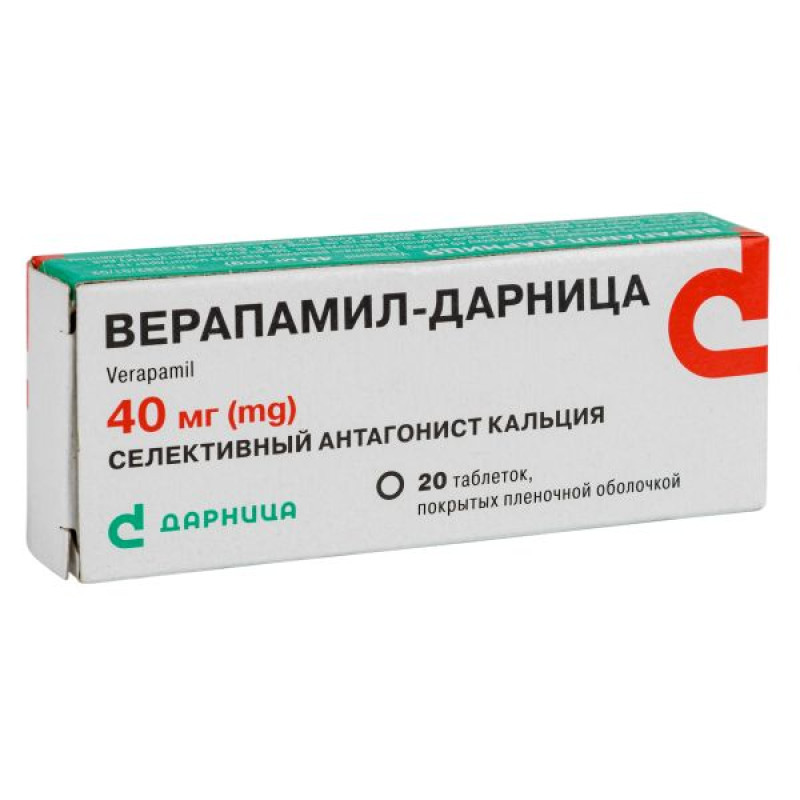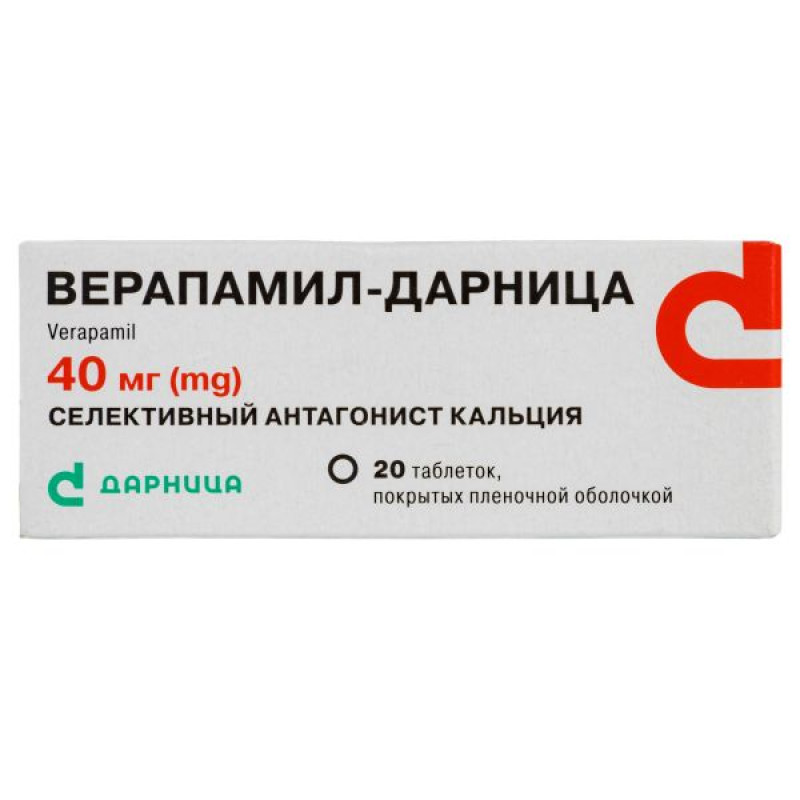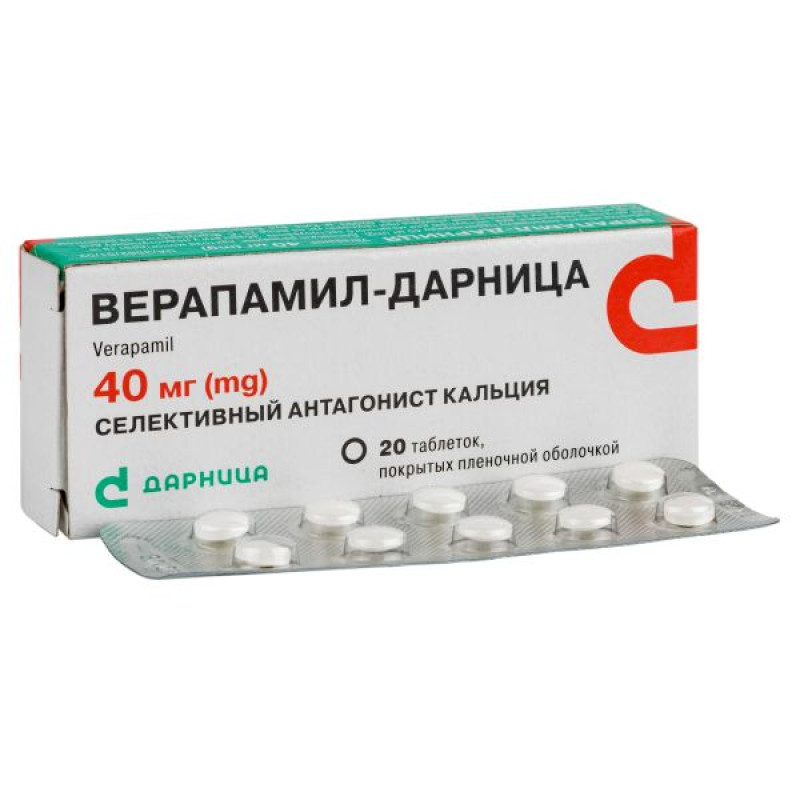Verapamil-Darnitsa film-coated tablets 40 mg No. 20

Pharmacological properties
Pharmacodynamic parameters. Verapamil, a synthetic derivative of papaverine, is a non-dihydropyridine blocker of slow L-type calcium channels. The effects of verapamil are caused by selective inhibition of the transmembrane current of Ca2+ in myocardial cells, smooth muscles of the walls of the coronary and systemic arteries, and the intracardiac conduction system.
Verapamil slows down the conduction of excitation and prolongs the effective refractory period within the AV node, depending on the conduction velocity. This leads to ventricular rhythm disturbances in patients with atrial flutter and/or atrial fibrillation and rapid ventricular response. By interrupting the re-entry of excitation into the AV node (re-entry mechanism), verapamil restores normal sinus rhythm in patients with paroxysmal supraventricular tachycardia. Verapamil does not affect the conduction of excitation through additional pathways; it does not change the normal action potential in the atria or the conduction time in the interventricular septum, but it reduces the amplitude, rate of depolarization and conduction in hypopolarized fibers. Verapamil has a local anesthetic effect, 1.6 times greater than that of procaine.
Reducing the tone of vascular smooth muscles prevents spasms of the coronary arteries both in areas with normal blood flow and in areas of ischemia.
Verapamil hydrochloride has an antihypertensive effect by causing peripheral vasodilation and reducing systemic vascular resistance without reflex tachycardia. Verapamil does not impair the hemodynamic response to isometric or isotonic exercise.
Verapamil reduces myocardial oxygen consumption by directly affecting energy-consuming metabolic processes in the cardiomyocyte (by slightly reducing heart rate and contractility of the heart muscle) and indirectly reducing OPSS (by reducing afterload both at rest and during exercise).
Verapamil increases the efficiency of the mechanical work of the heart.
In most patients, including those with organic heart disease, the negative inotropic effect of verapamil is counteracted by a decrease in afterload, and the cardiac index usually does not decrease.
Verapamil administration does not affect the total level of calcium in the blood plasma.
After a single intravenous injection of verapamil, hemodynamic effects peak within 5 min and persist for 10-20 min; effects on the AV node appear within 1-2 min, peak within 10-15 min, and persist for 10-20 min. The effects on the AV node may last up to 6 hours. Commonly used intravenous doses of 5-10 mg verapamil cause a short-term, usually asymptomatic decrease in normal systemic blood pressure, OPSS, and myocardial contractility; left ventricular filling pressure is slightly increased.
Pharmacokinetic parameters. After intravenous infusion in humans, verapamil is eliminated biexponentially with a rapid early distribution phase (T½ about 4 min) and a slower terminal elimination phase (T½ 2-5 h). Intravenous verapamil is rapidly metabolized.
In healthy subjects, orally administered verapamil (90%) is rapidly absorbed in the small intestine. About 90% of verapamil is bound to plasma proteins. Bioavailability is 20-35% (increasing with repeated administration). C max in plasma is reached 1-2 hours after administration. T ½ is 3-7 hours with a single dose and 4.5-12 hours with a course dose. Multiple oral administration of 120 mg of verapamil every 6 hours results in plasma verapamil concentrations in the range of 125-400 ng/ml.
It undergoes extensive metabolism mediated by the cytochrome P450 system during the first pass through the liver with the formation of 12 metabolites. The main metabolic pathways of verapamil are N-dealkylation (by CYP 3A4 and CYP 1A2) and N-demethylation (CYP 3A4). In quantities exceeding trace levels, only the verapamil metabolite norverapamil is determined in blood plasma (it exhibits 20% of the cardiovascular activity of the parent compound). Approximately 70% of the administered dose of verapamil is excreted within 5 days in the urine. 16% in the feces. About 3-4% of the dose is excreted from the body unchanged. Neither verapamil nor norverapamil are removed during hemodialysis.
T½ increases in the elderly.
In patients with hepatic insufficiency, metabolism slows down and T½ increases to 14-16 hours.
Indication
pills
paroxysmal supraventricular tachycardia;
atrial flutter/fibrillation with rapid AV conduction (except WPW syndrome);
stable angina pectoris;
angina at rest;
vasospastic angina;
post-infarction angina in patients without heart failure in the presence of contraindications to the appointment of β-adrenergic blockers;
AG.
R-r
paroxysmal supraventricular tachycardia;
atrial fibrillation (except WPW syndrome);
unstable angina in patients with contraindications to the use of nitrates and/or β-adrenergic blockers (including vasospastic angina);
AG;
hypertensive crisis.
In children, it is used for paroxysmal supraventricular tachycardia.
Application
Tablets. The dose is selected individually. The tablet is taken whole, in a sitting or standing position, during or immediately after a meal, with sufficient liquid.
Treatment of coronary artery disease, paroxysmal supraventricular tachycardia, atrial fibrillation: daily dose - 120-480 mg (in 3-4 doses).
Hypertension therapy: daily dose - 120-360 mg (in 3 doses).
Children (exclusively for cardiac arrhythmias)
6 years: daily dose - 80-120 mg (in 2-3 doses).
6-14 years: daily dose - 80-360 mg (in 2-4 doses).
Verapamil hydrochloride should be used with caution in cases of decreased renal function.
With reduced liver function, the use of verapamil hydrochloride is started with caution, with low doses (40 mg 2-3 times a day at the initial stage).
Discontinuation of the drug after long-term treatment should be gradual.
The duration of treatment is determined individually by the doctor.
The solution is administered intravenously slowly (≥2 min; under the supervision of medical personnel, with ECG and blood pressure monitoring).
If verapamil is administered intravenously as initial treatment to a patient with unstable angina, it is necessary to switch to oral administration of the drug as soon as possible.
In adults and adolescents weighing 50 kg, the starting dose of Verapamil-Darnitsa, solution for injection, is 2 ml; if necessary, another 2 ml is administered after 5-10 minutes.
Further drip administration of 2-4 ml of Verapamil-Darnitsa diluted in 0.9% NaCl solution or 5% glucose solution (with pH 6.5) over 1 hour is possible.
With intravenous administration, the average daily dose is ≤100 mg of verapamil hydrochloride.
With reduced liver function, the use of verapamil hydrochloride should be initiated with caution.
Children. For tachycardia associated with heart failure, digitalization is necessary before IV administration.
Dose of Verapamil-Darnitsa, solution for injection, in children:
newborns - 0.3-0.4 ml;
chest age - 0.3-0.8 ml;
1 year - 5 years - 0.8-1.2 ml;
6-14 years old - 1-2 ml.
Verapamil-Darnitsa, solution for injection, is administered to children under the age of 1 only for vital indications in the absence of other therapy options.
The use of Verapamil-Darnitsa is discontinued immediately after the result occurs.
Contraindication
Cardiogenic shock;myocardial infarction (in the acute phase) with complications (heart failure, decrease in heart rate ≤50 beats / min, blood pressure ≤90 / 60 mm Hg);
severe conduction disorders: sinoatrial or AV block (II and III degree), exception - patients with an implanted artificial pacemaker;
decrease in heart rate ≤50 beats / min, blood pressure ≤90 / 60 mm Hg;
sick sinus syndrome (Contraindications), exception - patients with an implanted artificial pacemaker;
heart failure (decompensation stage);
atrial fibrillation with concomitant WPW syndrome;
hypersensitivity to the active pharmaceutical ingredient of the drug or its other components.
Intravenous administration is contraindicated while taking β-adrenergic blockers (exception - resuscitation measures).
In acute coronary insufficiency, intravenous administration of verapamil must be carefully justified (to exclude myocardial infarction) with mandatory monitoring of the patient's condition.
Side effects
Bronchial spasm;abdominal pain and discomfort, feeling of fullness in the stomach, nausea, vomiting, constipation, intestinal obstruction, gingivitis and bleeding gums;
hepatitis (with temporary increase in liver enzyme activity);
decreased glucose tolerance;
tinnitus, dizziness; headache, fainting, lethargy, drowsiness, fatigue, asthenia, depression, anxiety, extrapyramidal disorders, Parkinson's syndrome, choreoathetosis, paresthesia, tremor, convulsions;
AV block (any degree), decreased heart rate (≤50 beats / min) or increased heart rate (≥90 beats / min), heart failure (increased severity or onset); angina pectoris, myocardial infarction, pronounced decrease in blood pressure, heart rhythm disturbances, flushing, peripheral edema;
hypersensitivity reactions;
Quincke's edema, Stevens-Johnson syndrome, erythema multiforme, rash (maculo-papular), urticaria, alopecia, erythromelalgia, itching, purpura, photodermatitis, increased sweating;
pain in muscles, joints, muscle weakness, exacerbation of myasthenia gravis, progressive Duchenne muscular dystrophy;
erectile dysfunction, gynecomastia, increased prolactin levels, galactorrhea;
weight gain, agranulocytosis, transient (against the background of C max in the blood plasma of verapamil) vision loss, pulmonary edema, asymptomatic decrease in platelet count (150⋅10 9 / l).
In newborns and infants, after intravenous administration, pronounced hemodynamic disturbances (in some cases, with a fatal outcome) are rare.
Special instructions
A decrease in blood pressure ≤90/60 mm Hg (usually transient and asymptomatic) is often observed with intravenous administration of verapamil hydrochloride.
Possible development of AV block (II-III degree), pronounced decrease in heart rate and asystole (in patients with Contraindications). In patients without Contraindications, asystole is usually short-lived (with independent return to AV rhythm or normal sinus rhythm).
In the event of the development of second- or third-degree AV block (or bundle branch block), the dose of verapamil should be reduced or the use of verapamil discontinued.
Acute deterioration of the condition is possible in patients with moderate and severe heart failure. In patients with mild heart failure, preliminary use of cardiac glycosides and diuretics is indicated to control the condition. Monitoring for the development of AV block and a decrease in heart rate (≤50 beats / min) is necessary when used simultaneously with cardiac glycosides.
Verapamil-Darnitsa, solution for injection, at the beginning of therapy is used exclusively in a hospital setting (with the possibility of intensive care) with monitoring of the patient's condition (ECG, cardiac monitoring).
Verapamil-Darnitsa tablets contain 31.4 mg of lactose monohydrate (to be taken into account by patients with intolerance to some sugars).
Verapamil is not used in the I and II trimesters of pregnancy. Admission in the III trimester of pregnancy - in case of extreme necessity, if the benefit of using the drug outweighs the risk to the mother and child.
Verapamil should be used during breastfeeding only if absolutely necessary for the mother.
Verapamil hydrochloride, solution for injection, should be used with caution in children.
Reaction disturbances are possible when performing activities that require increased attention and speed of reactions.
Interactions
Concomitant use with verapamil:
• antiarrhythmics, β-adrenergic blockers - the cardiovascular effect is summed up (pronounced decrease in blood pressure, heart rate, AV block, heart failure - exacerbation or occurrence);
• oral clearance of quinidine is reduced. Possible decrease in blood pressure ≤90/60 mm Hg, development of pulmonary edema (in patients with hypertrophic obstructive cardiomyopathy);
• flecainidine clearance in blood plasma changes minimally (≈10%);
• in patients with angina pectoris, AUC (≈32.5%) and C max (≈41%) of metoprolol, AUC (≈65%) and C max (≈94%) of propranolol increase;
prazosin, terazosin - additional reduction in blood pressure (increase in C max of prazosin (≈40%) without effect on T ½; increase in AUC (≈24%) and C max (≈25%) of terazosin);• antihypertensives, diuretics, vasodilators - increased hypotensive effect;
• antiviral (HIV) drugs - possible increase in the blood level of verapamil;
• carbamazepine - increased levels of carbamazepine, development of its neurotoxic side effects. Increased AUC of carbamazepine (≈46%) in patients with refractory partial epilepsy;
• lithium - increased neurotoxicity;
• clarithromycin, erythromycin, telithromycin may increase verapamil levels;
• rifampicin - possible reduction of the hypotensive effect. Reduction of verapamil AUC (≈97%), its C max (≈94%) and bioavailability after oral administration (≈92%);
• increased exposure to colchicine (incompatible);
• inhalation anesthetics are used with caution;
• possible enhancement of the effect of neuromuscular blockers;
• acetylsalicylic acid - likely increased risk of bleeding;
• ethanol - increased content in blood plasma;
• the level of lovastatin, atorvastatin increases. Atorvastatin increases the AUC of verapamil (by ≈42.8%):
• simvastatin - increase in AUC by ≈2.6 times, Cmax - by 4.6 times;
• interaction with verapamil does not occur with fluvastatin, pravastatin and rosuvastatin;
• C max of digoxin increases by 45-53%, C ss - by 42%, AUC - by 52%;
• digitoxin clearance decreases;
• cimetidine increases AUC with a corresponding decrease in verapamil clearance;
• increases C max of glyburide (by ≈28%), AUC (by 26%);
• oral and systemic clearance of theophylline decreases (by ≈20%, in smokers - by 11%);
• AUC increases (≈15%) of imipramine (desipramine - the active metabolite - is not affected);
• with simultaneous oral administration in patients with small cell lung cancer, the AUC (≈89%) and Cmax (≈61%) of doxorubicin increase;
• phenobarbital increases the oral clearance of verapamil by 5 times;
• midazolam - increase in AUC by 3 times and C max (by 2 times);
• buspirone - increase in AUC and C max (3-4 times);
• almotriptan - increase in AUC by 20%, C max (by 24%);
• cyclosporine - increase in AUC, Cmax, Css (by ≈45%);
• possible increase in the level of everolimus, sirolimus, tacrolimus;
• grapefruit juice increases the AUC and C max of verapamil (T ½ and renal clearance do not change);
• St. John's wort reduces the AUC and C max of verapamil.
Verapamil hydrochloride solution should not be mixed with albumin, amphotericin B, hydralazine hydrochloride, trimethoprim and sulfamethoxazole. Do not dilute with solutions containing sodium lactate, or with any solution with a pH of 6.0.
Overdose
It is manifested by significant hypotension, cardiac arrhythmias leading to shock and cardiac arrest, dizziness, stupor, decreased blood potassium levels, hyperglycemia, metabolic acidosis, hypoxia, cardiogenic shock (with pulmonary edema), decreased renal function, and seizures.
Regardless of the time that has passed after taking verapamil, gastric lavage is performed.
Indirect heart massage, artificial respiration, defibrillation, cardiac pacing are performed. Hemodialysis is not performed. Hemofiltration and plasmapheresis are required.
Specific antidote - calcium. Enter 10-20 ml of 10% calcium gluconate solution intravenously. If necessary, repeat or additionally carry out drip infusion.
In case of AV block (II and III degree), sinus bradycardia, cardiac arrest - atropine, isoprenaline, orciprenaline or electrocardiostimulation.
Elimination of hypotension - dopamine (at a dose of up to 25 mcg / kg / min), dobutamine (at a dose of up to 15 mcg / kg / min) or noradrenaline; in the early stages - the introduction of Ringer's solution or 0.9% NaCl. The required concentration of Ca 2+ in the blood plasma: the upper limit of normal or slightly higher than normal.
Storage conditions
At a temperature ≤25 °C in the original packaging. Do not freeze.
Translation of the instructions can be
There are no reviews for this product.
There are no reviews for this product, be the first to leave your review.
No questions about this product, be the first and ask your question.







